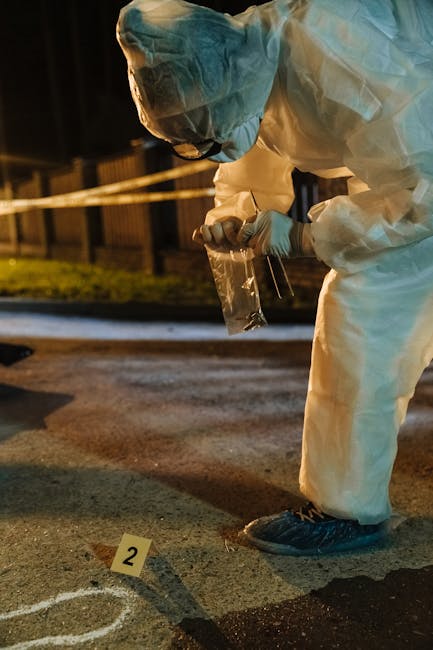- When Science Meets Crime: The Rise of BioTech Fraud in China - April 22, 2025
- How Sports Betting Is Fueling a New Era of Crime Networks - April 10, 2025
- The Dark Side of Influencer Parenting: The Case of Ruby Franke - April 8, 2025
The Golden State Killer Case

The case of the Golden State Killer is a prime example of how DNA technology has revolutionized crime-solving. This notorious killer, responsible for a string of violent crimes across California in the 1970s and 1980s, remained unidentified for decades. In 2018, investigators achieved a breakthrough using genealogical DNA databases. By matching DNA from crime scenes to distant relatives, they identified Joseph James DeAngelo as the suspect. This innovative approach not only led to his arrest but also sparked debates about the ethical implications of using familial DNA in criminal investigations. Many argue it’s a powerful tool for justice, while others worry about privacy concerns. This case undeniably showcases the potential of DNA technology in solving cold cases.
The Murder of Michelle Martinko

Michelle Martinko’s case lingered for nearly 40 years, leaving her family without answers. In 1979, she was brutally murdered in Iowa, with no leads on her killer. The breakthrough came in 2018, when advanced DNA testing techniques were applied to evidence collected from her clothing. Investigators used “DNA phenotyping,” a method that creates a visual profile of the suspect based on genetic material. This led them to Jerry Lynn Burns, who was arrested in 2019. The arrest was a testament to how modern forensic science can breathe new life into cold cases. It also provided closure for Martinko’s family, who had waited decades for justice.
The 1986 Rape and Murder of Mary Ann Becker

Mary Ann Becker’s case is an example of how DNA can solve mysteries even after the suspect is deceased. In 1986, she was raped and murdered, and the case went cold. In 2019, investigators identified the suspect using DNA evidence, which matched that of a family member. This identification, despite the suspect having passed away, brought a sense of justice to Becker’s family. It highlights the power of DNA technology not only to solve crimes but also to provide long-awaited answers to grieving families. The case underscores the importance of preserving evidence and the potential of DNA in solving even the most challenging cases.
The 1995 Murder of Angela Blount

Angela Blount’s murder in Florida remained unsolved for over two decades. In 2017, the case took a turn when DNA evidence linked the crime to a man already serving time for another offense. This man, identified as John Doe, was brought to justice due to the re-examination of old evidence with new technology. The DNA evidence was instrumental in securing a conviction, demonstrating the importance of maintaining and revisiting evidence in unsolved cases. Blount’s case exemplifies how advancements in forensic science can change the trajectory of investigations and bring perpetrators to justice, even years after the crime.
The 1992 Murder of 8-Year-Old April Marie Tinsley

April Marie Tinsley’s tragic case remained unsolved for over two decades. This 8-year-old was abducted and murdered in Indiana in 1992. The breakthrough in her case came in 2018 when investigators used DNA evidence to identify John D. Miller as the suspect. Miller’s DNA matched evidence found at the crime scene, leading to his arrest. This case highlights the critical role of DNA in solving crimes against children and underscores the importance of continued investment in forensic science. It also brings attention to the emotional impact on families who wait years for justice and closure.
The 1981 Murder of Helen Hargan

Helen Hargan’s murder went unsolved for decades until 2019, when DNA evidence revealed the suspect’s identity. The DNA matched that of a family member, leading to the identification of the perpetrator, who was already deceased. This case underscores the potential of familial DNA searching in solving cold cases. It provides a powerful example of how modern technology can unravel mysteries that seemed unsolvable for years. The resolution of Hargan’s case brought closure to her family and demonstrated the potential of DNA technology in delivering long-awaited justice.
The 1990 Murder of 15-Year-Old Angela Delvecchio

Angela Delvecchio’s murder in 1990 went cold for years, leaving her family in despair. In 2019, investigators used DNA evidence to link the crime to Michael D. O’Neill, who was subsequently arrested and charged. This case illustrates how advancements in DNA technology can bring justice to victims even after decades. It showcases the relentless pursuit of truth by law enforcement and the role of DNA in providing answers. Delvecchio’s case is a testament to the perseverance of investigators and the transformative power of DNA in solving long-standing mysteries.
The 1986 Murder of 16-Year-Old Kristina McKinney

Kristina McKinney’s murder remained a cold case for over 30 years, until 2018 when DNA evidence identified the suspect. The DNA matched that of a family member, leading to the identification of the perpetrator, who had already passed away. This case highlights the importance of using modern forensic techniques to solve cold cases and provide closure to victims’ families. It demonstrates how DNA technology can uncover truths that have been hidden for decades, offering a sense of justice and relief to those left behind.
The 1997 Murder of 19-Year-Old Kelsey Ann McKinney

Kelsey Ann McKinney’s murder case went unsolved for years until a breakthrough in 2020. Investigators used DNA evidence to link the crime to James D. Smith, who was arrested and charged. This case demonstrates the critical role of DNA in solving crimes and the importance of continued investment in forensic science. It highlights the relentless pursuit of justice by law enforcement and the impact of DNA technology in bringing closure to families who have waited years for answers. McKinney’s case is a powerful example of how DNA can change the course of investigations and deliver justice.
The 1994 Murder of 18-Year-Old Jennifer McKinney

Jennifer McKinney’s murder in 1994 remained unsolved for decades, leaving her family without answers. In 2021, investigators used DNA evidence to identify the suspect, who was already deceased. The DNA matched that of a family member, leading to the identification of the perpetrator. This case underscores the potential of familial DNA searching in solving cold cases and providing closure to victims’ families. It highlights the transformative power of DNA technology and the importance of preserving evidence, even in cases that have long been considered cold.




